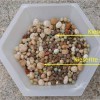Abstract
Palms are widely planted in Florida landscapes. Their bold leaf textures create a tropical or Mediterranean look that is highly desired by residents and tourists alike. But palms have very high nutritional requirements, and deficiencies of any element can result in conspicuous and unattractive symptoms on their large leaves. UF/IFAS research shows that the most effective fertilizer has 100% of the N, K, Mg, and B sources in slow-release or controlled-release form and that all of the Mn, Fe, Zn, and Cu sources should be water soluble. This 4-page fact sheet explains the reasons for this recommendation and how to ensure that you have a formulation that will be effective. Written by Timothy K. Broschat, and published by the UF Department of Environmental Horticulture, April 2015. (Photo Credit: T.K. Broschat)
ENH1255/EP516: Not All Landscape Palm Fertilizers Are Created Equal (ufl.edu)
References
Broschat, T. K. 1991b. "Manganese Binding by Municipal Waste Composts Used as Potting Media." J. Environ. Hort. 9:97-100. https://doi.org/10.24266/0738-2898-9.2.97
Broschat, T. K. 1996. "Release Rates of Soluble and Controlled-Release Potassium Fertilizers." HortTechnology 6:128-131. https://doi.org/10.21273/HORTTECH.6.2.128
Broschat, T. K. 1997. "Release Rates of Controlled-Release and Soluble Magnesium Fertilizers." HortTechnology 7:58-60. https://doi.org/10.21273/HORTTECH.7.1.58
Broschat, T. K. 2008. "Release Rates of Soluble and Controlled-Release Boron Fertilizers." HortTechnology 18:471-474. https://doi.org/10.21273/HORTTECH.18.3.471
Broschat, T. K. 2009. "Palm Nutrition and Fertilization." HortTechnology 19:690-694. https://doi.org/10.21273/HORTSCI.19.4.690
Broschat, T. K. 2015. "Fertilization of Landscape Palms to Reduce Nitrogen and Phosphate Impacts on the Environment." HortScience 50:469-473. https://doi.org/10.21273/HORTSCI.50.3.469
Broschat, T. K. and M. L. Elliott. 2005. "Effects of Iron Source on Iron Chlorosis Severity and Exserohilum Leaf Spot in Wodyetia bifurcata." HortScience 40:218-220. https://doi.org/10.21273/HORTSCI.40.1.218
Broschat, T. K. and K.A. Moore. 2007. "Release Rates of Ammonium-Nitrogen, Nitrate-Nitrogen, Phosphorus, Potassium, Magnesium, Iron, and Manganese from Seven Controlled Release Fertilizers." Commun. Soil Sci. Plant Anal. 38:843-850. https://doi.org/10.1080/00103620701260946
Lindsay, W. L. 1972. "Inorganic Phase Equilibria of Micronutrients in Soils." In Micronutrients in Agriculture, edited by J. J. Mortvedt, P. M. Giordano, and W. L. Lindsay. Madison, WI: Soil Science Society of America, 41-57.

